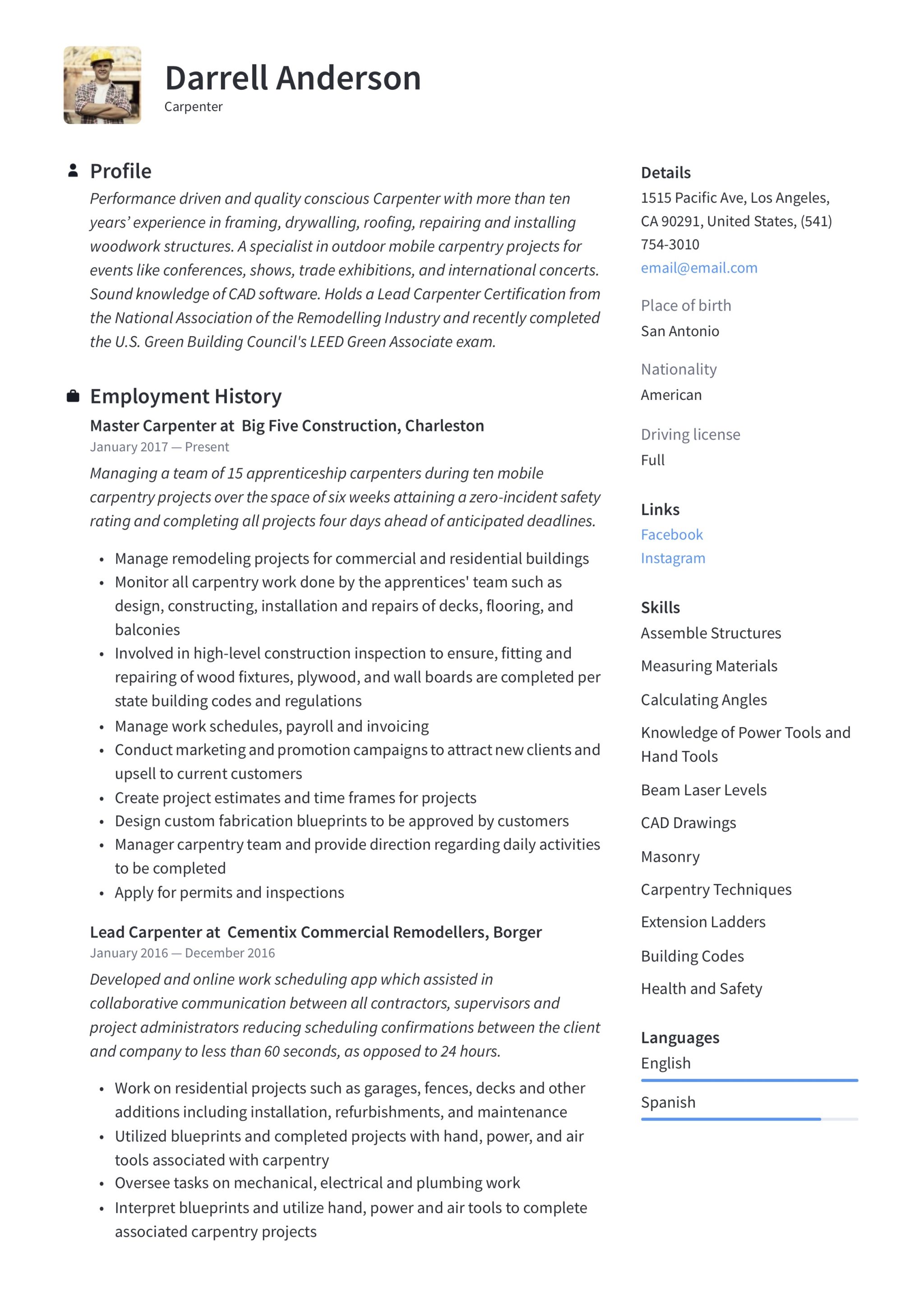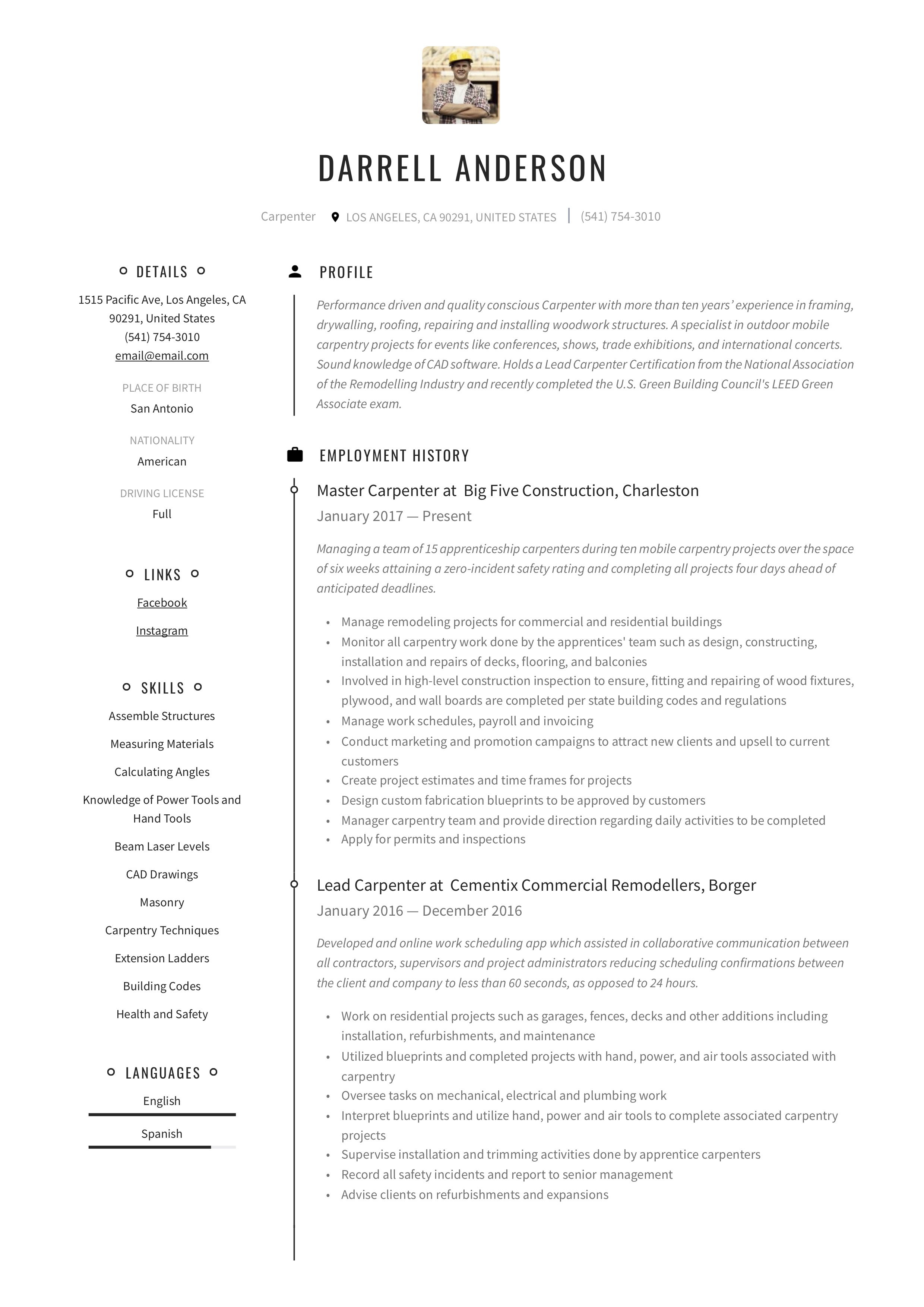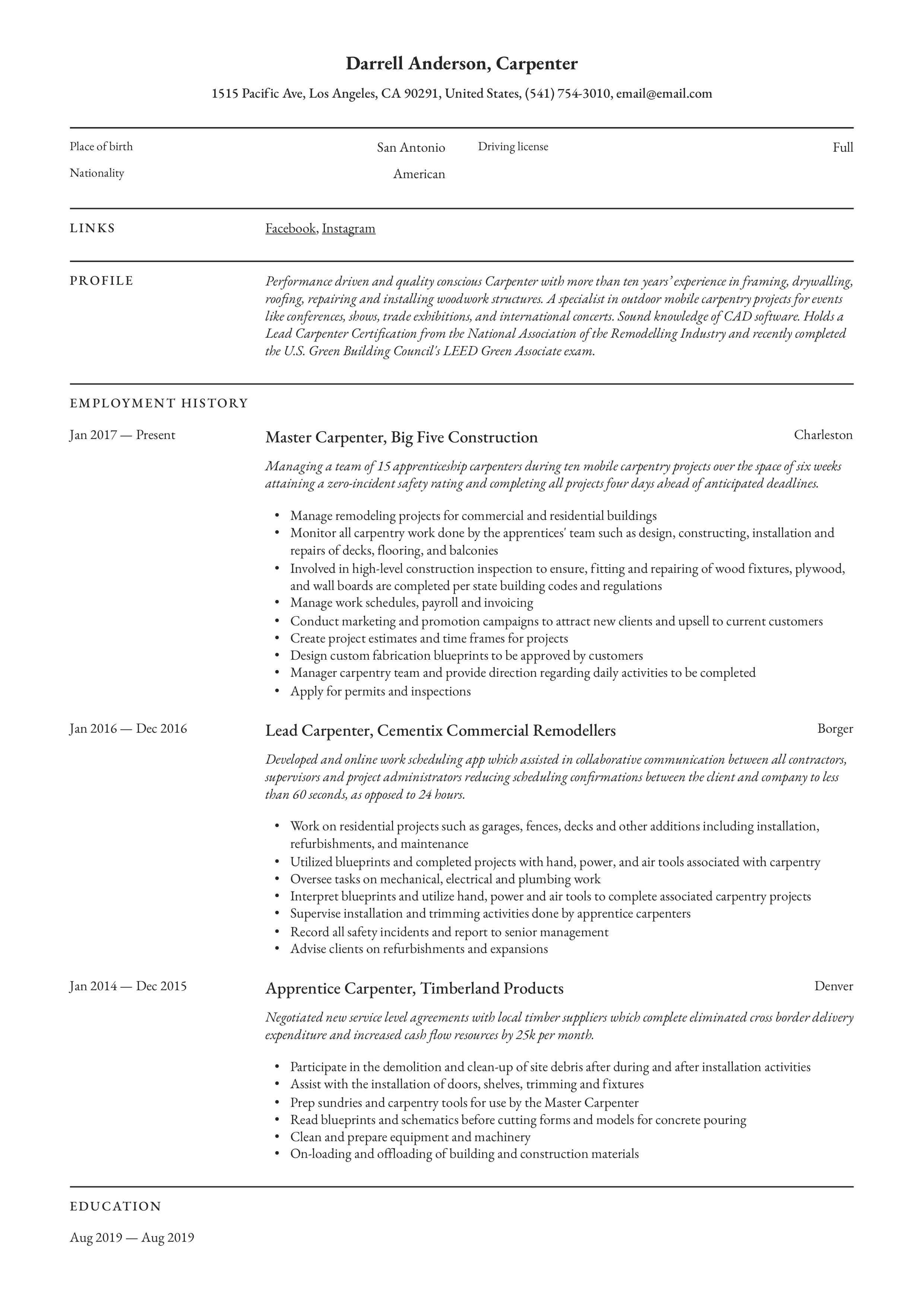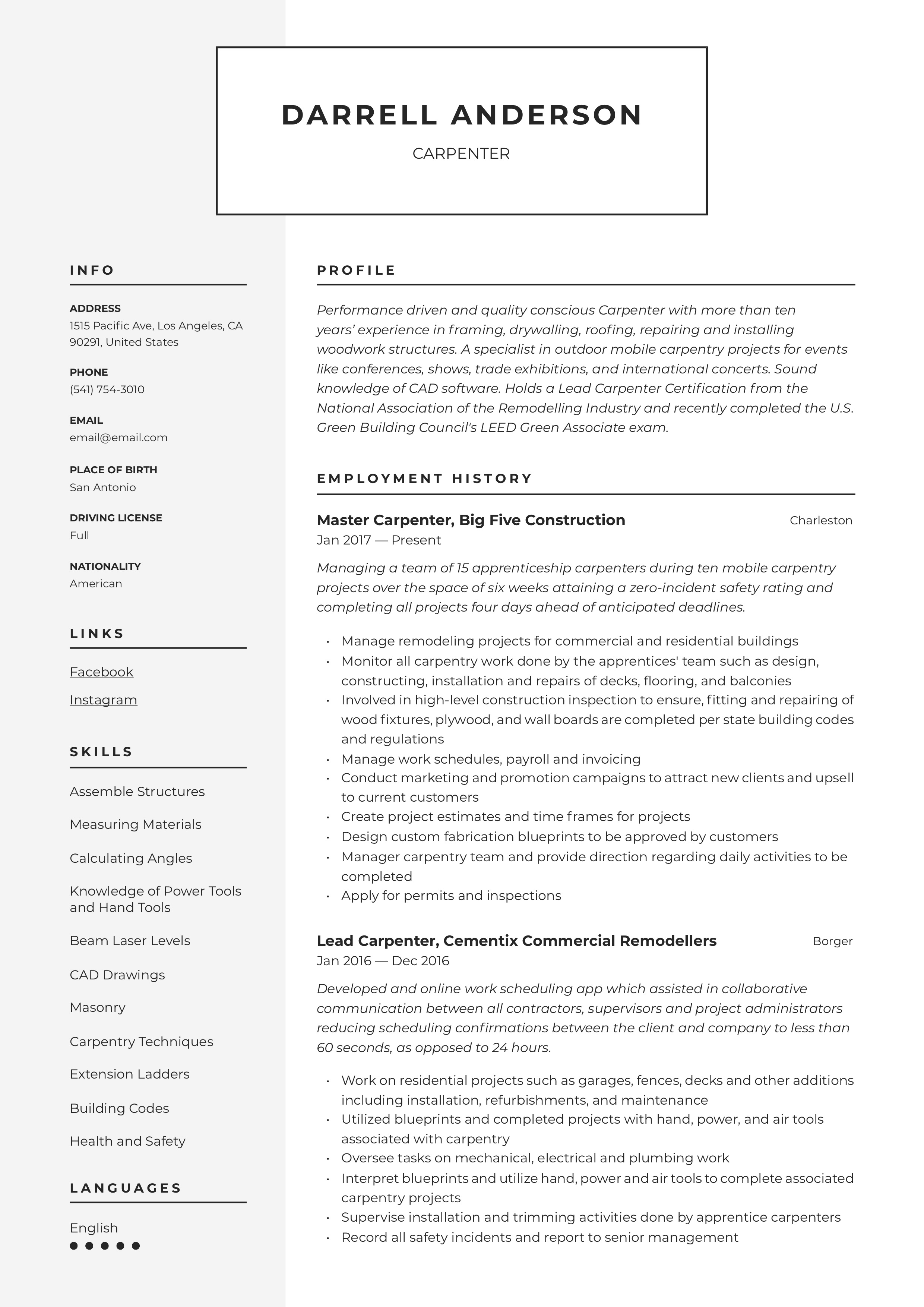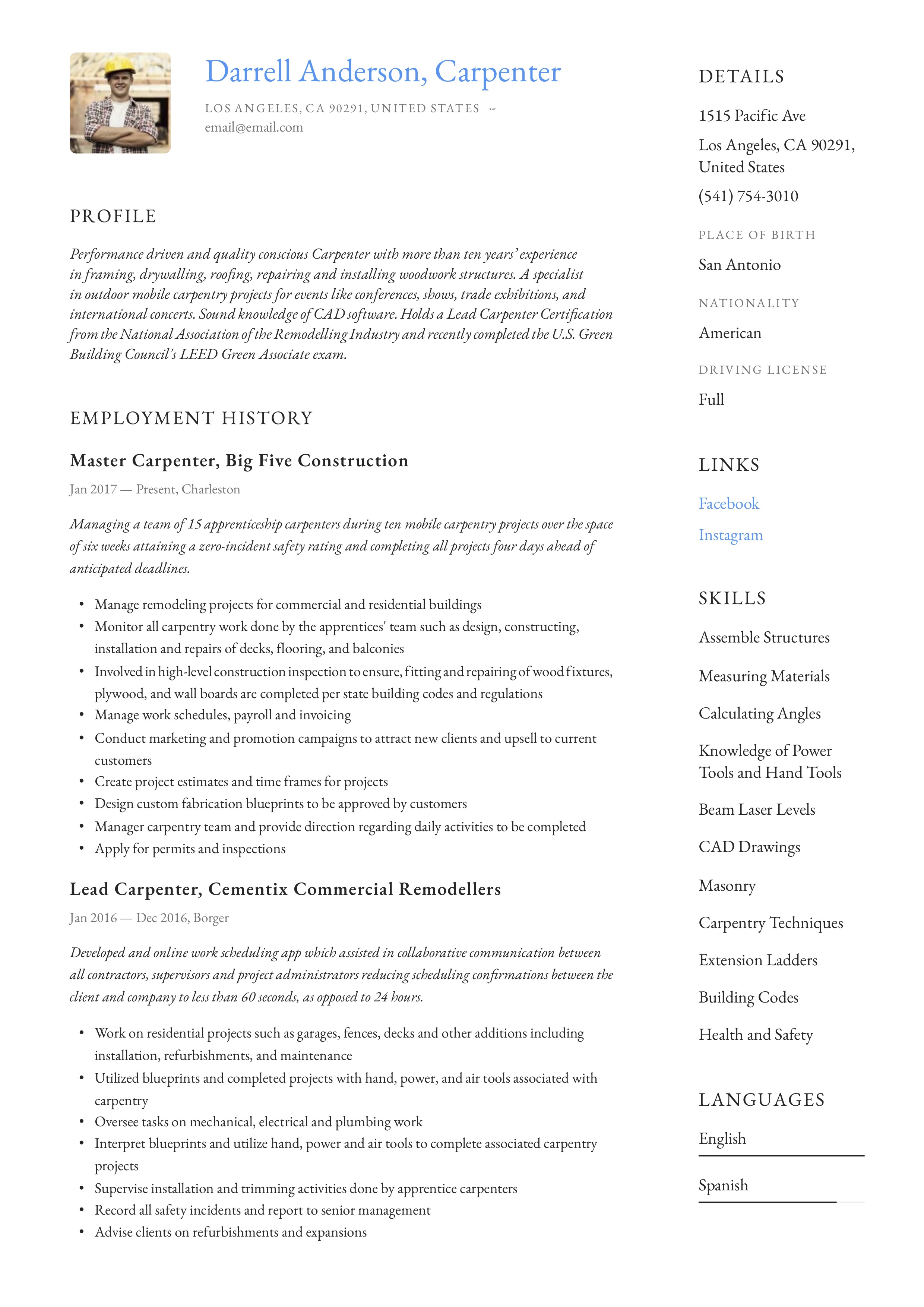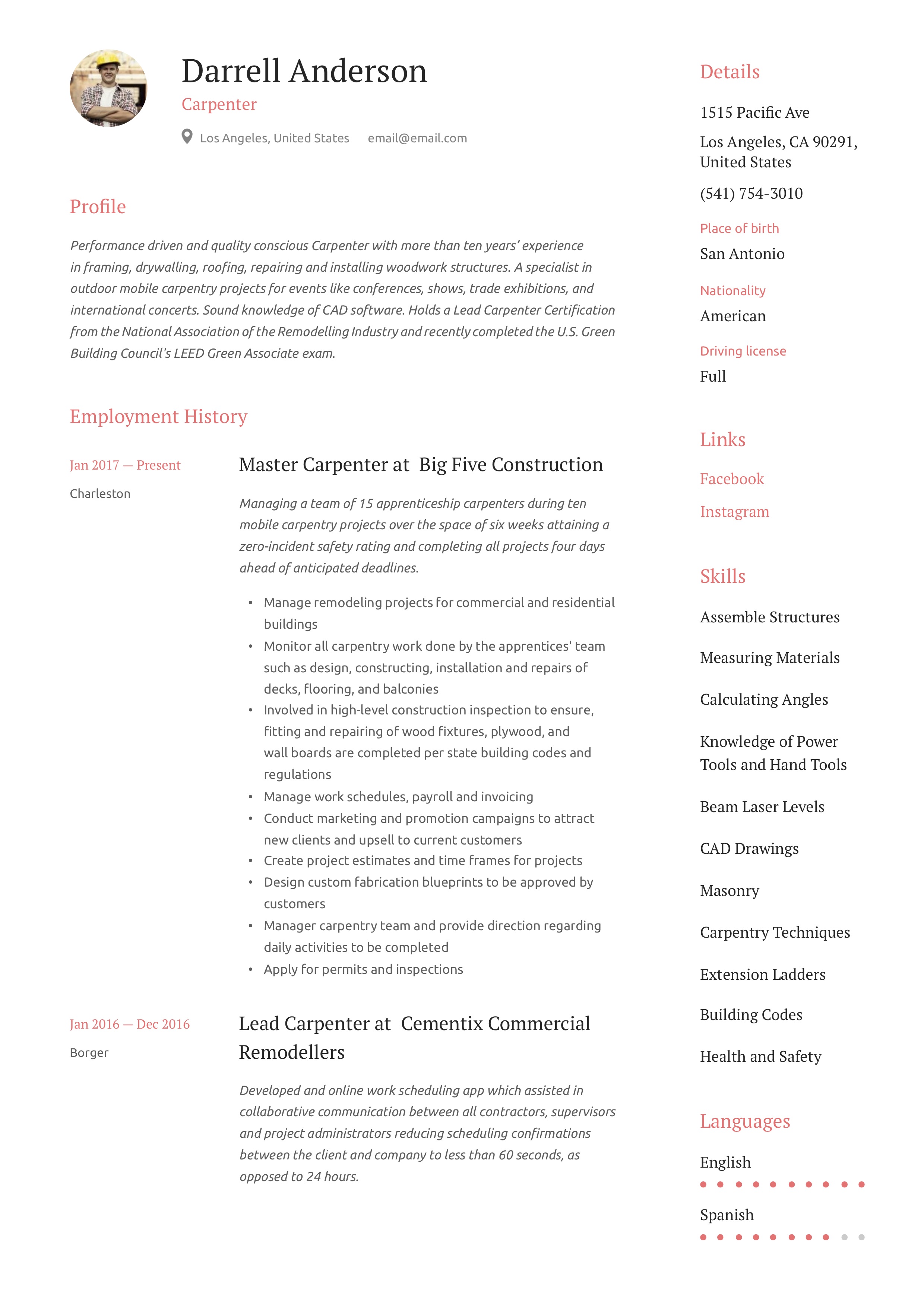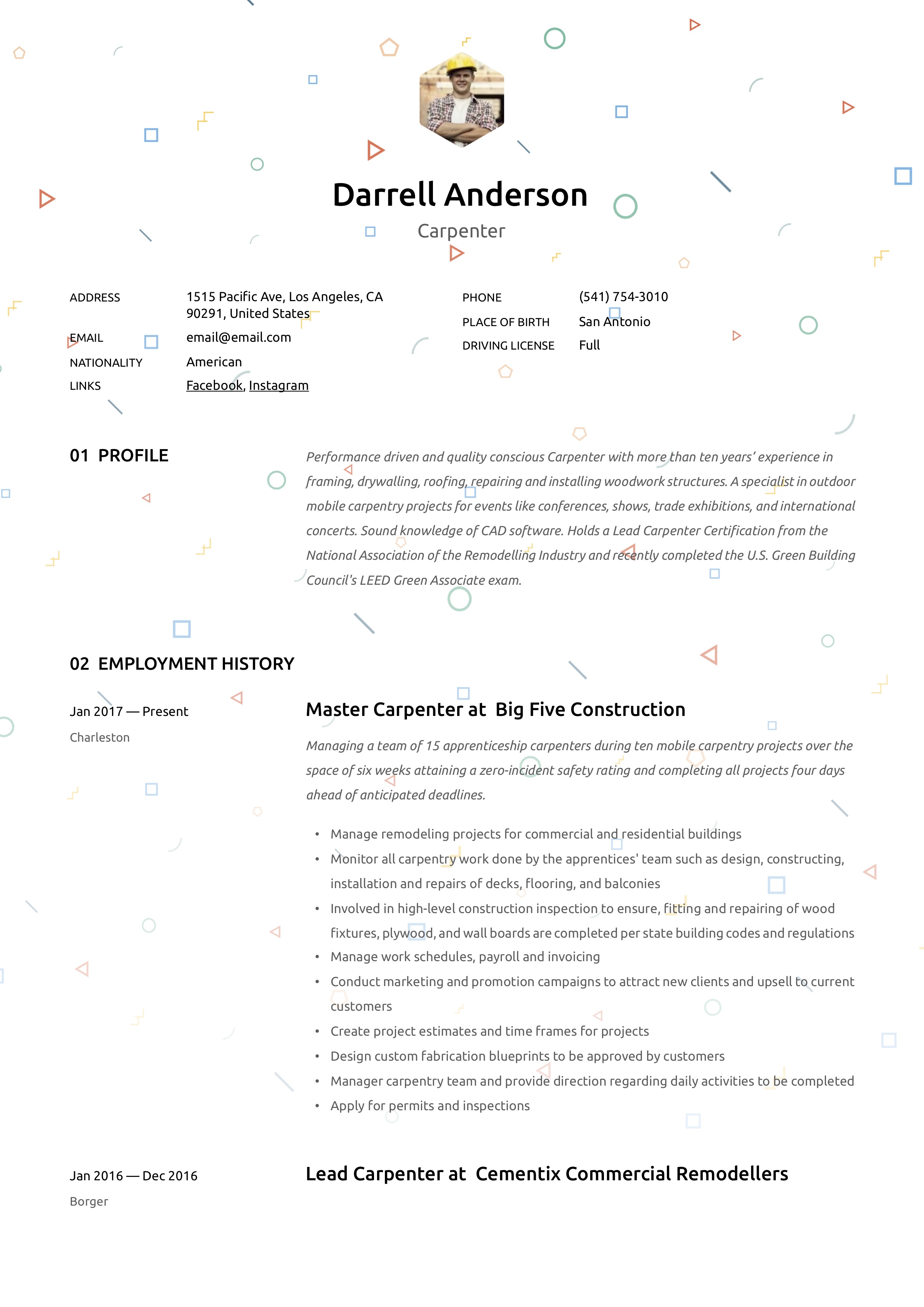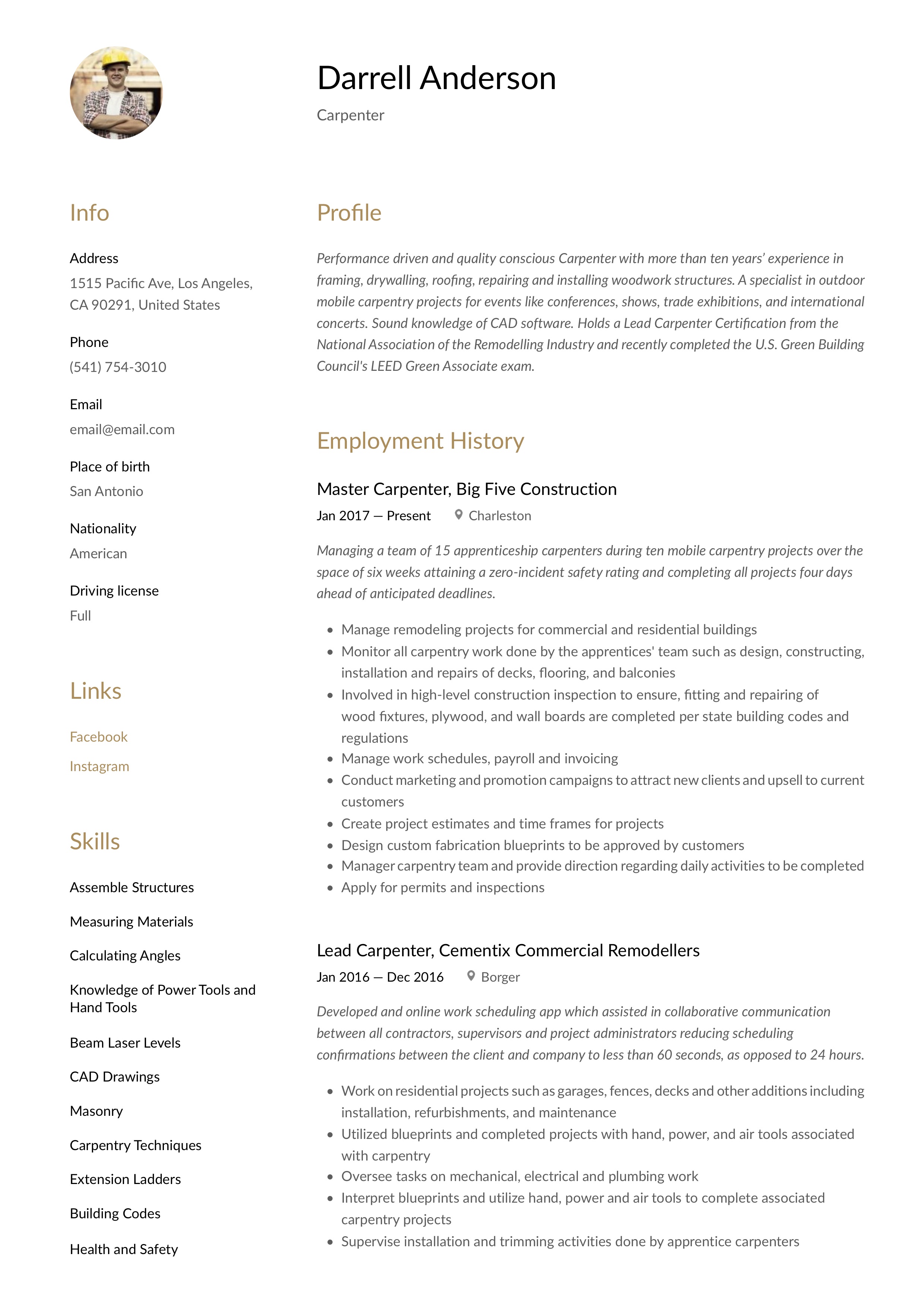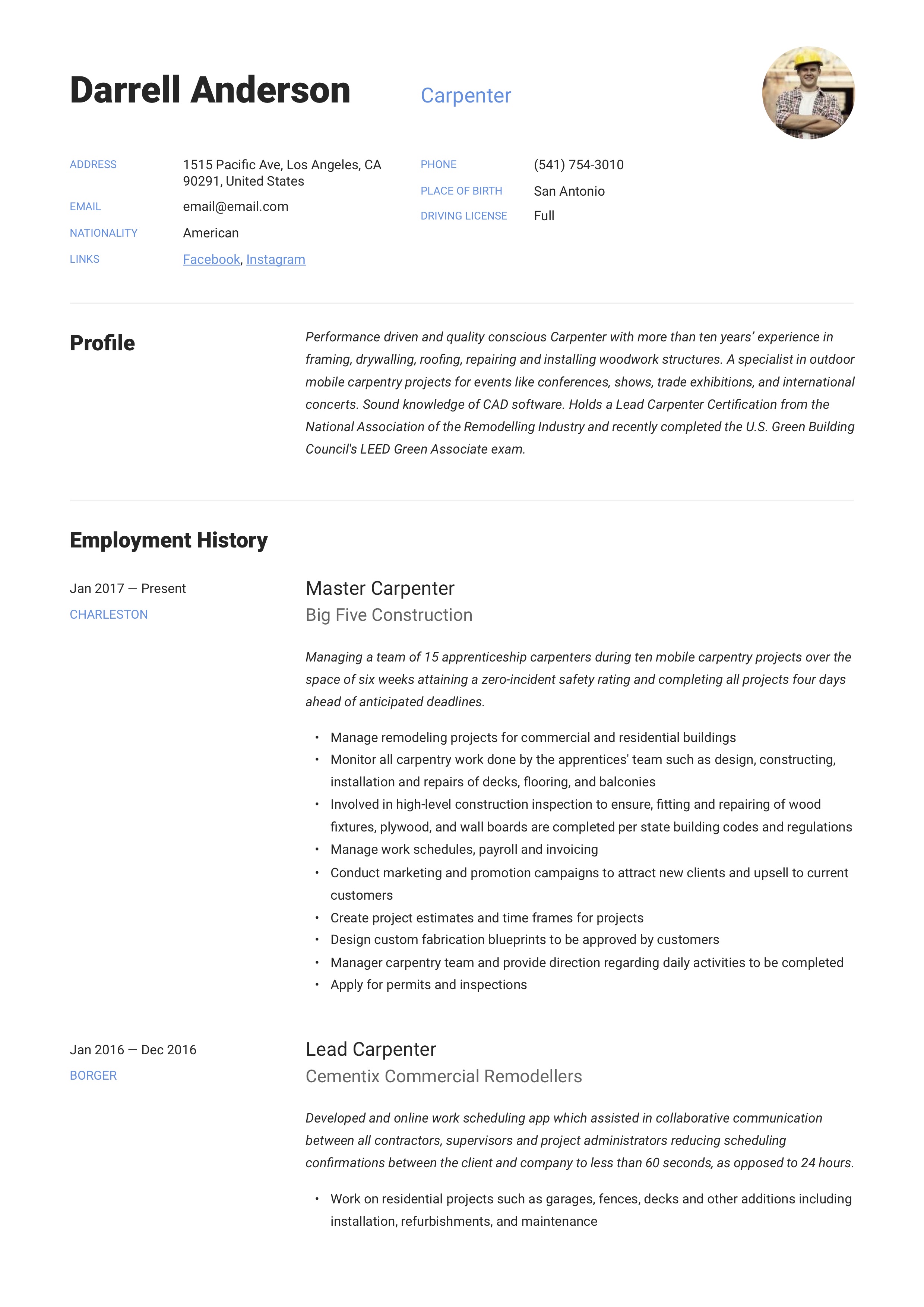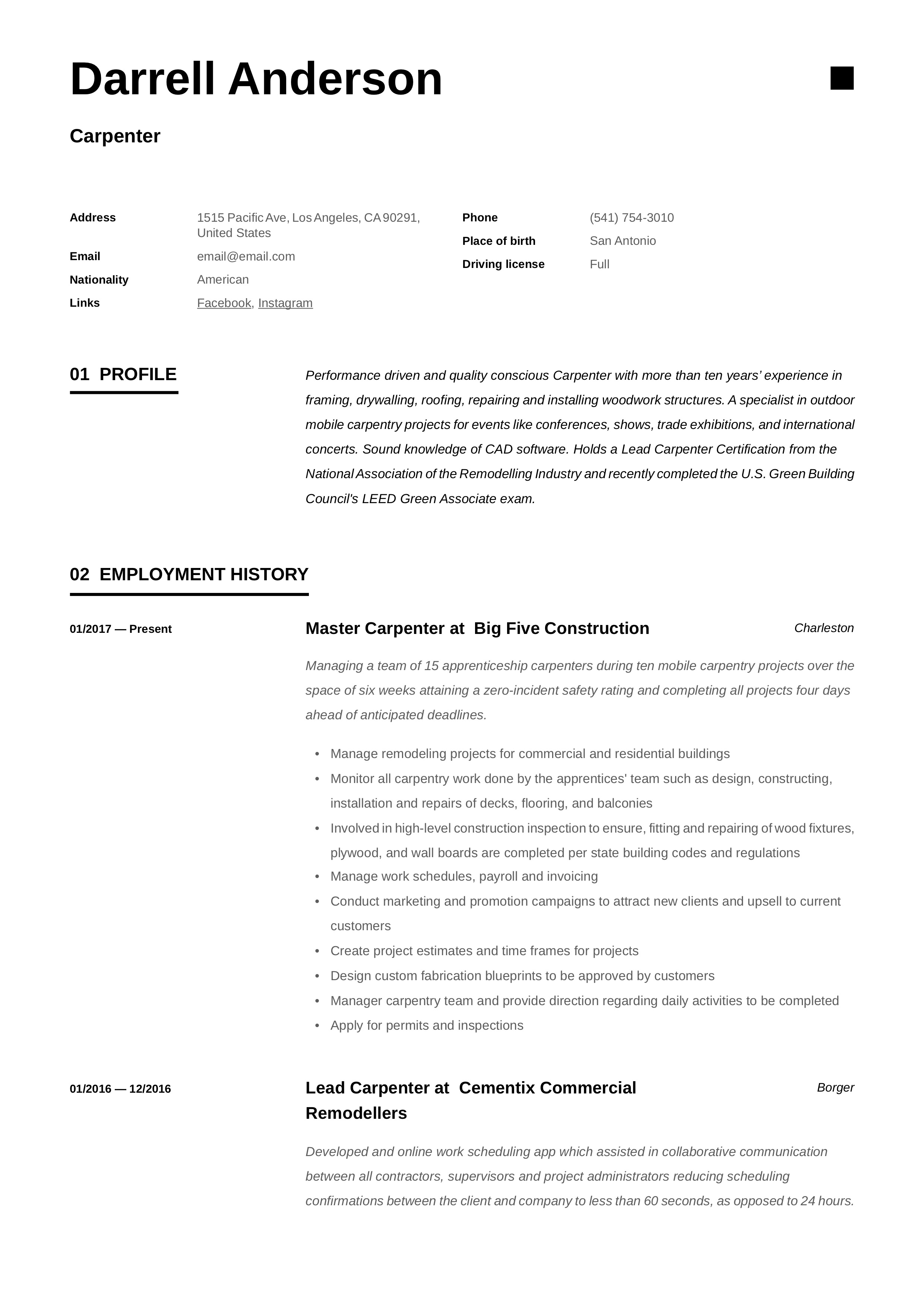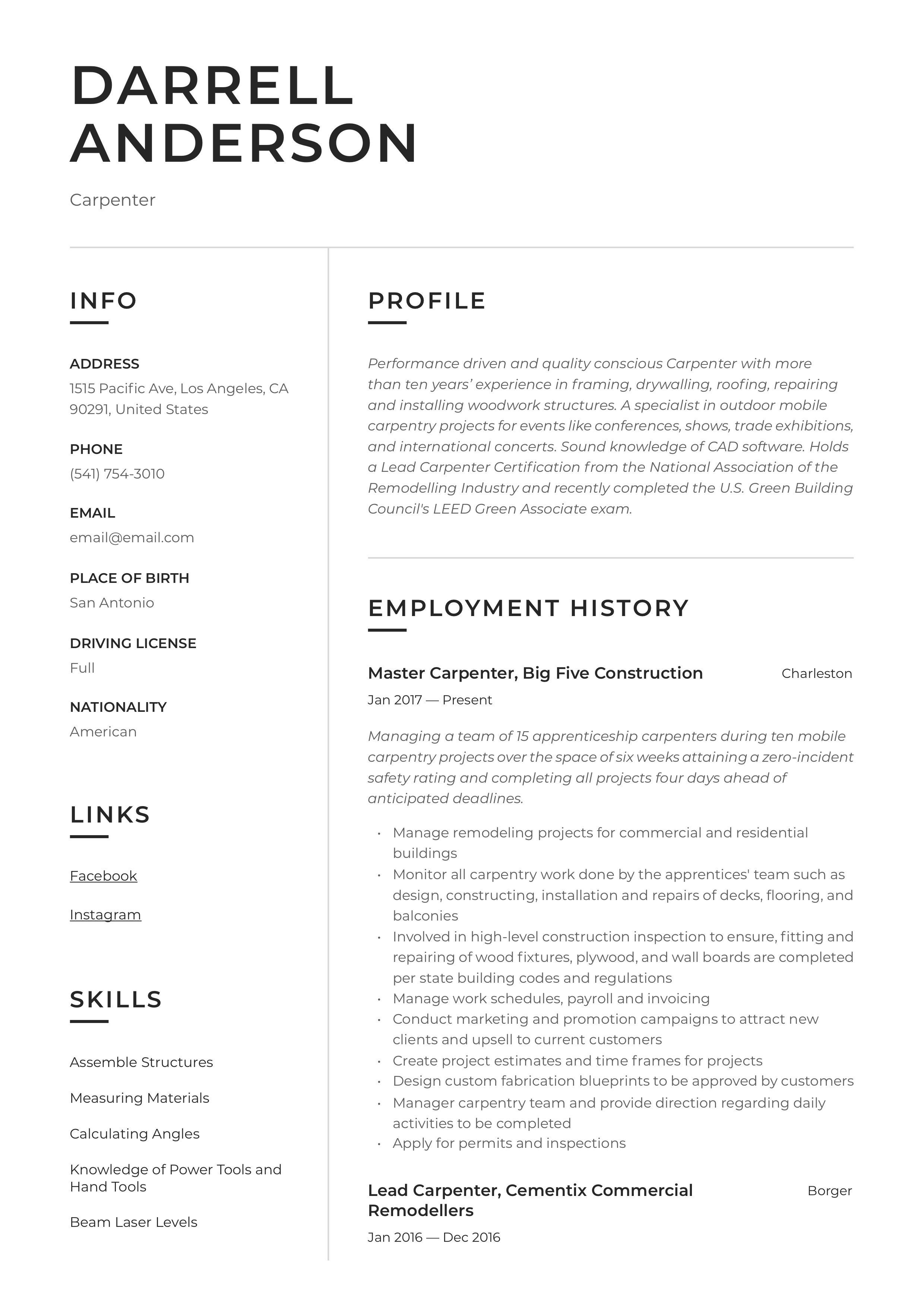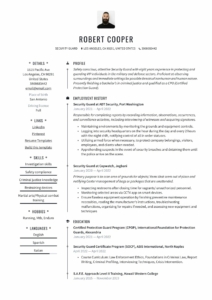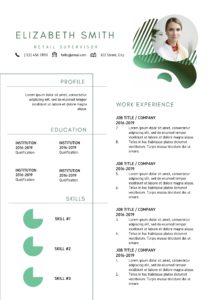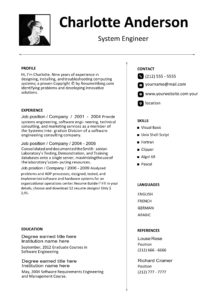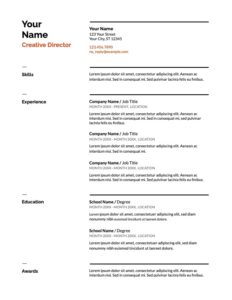When you are scouting for a position in carpentry, the quality of your resume could mean the difference between landing a job interview or ending up in the declined resume/cv stack.
Our Carpenter Resume examples will help you with a solid foundation for your own resume. We use samples with each resume section so you can speed up making yours, with proven examples in front of you.
Word of mouth is a fantastic mechanism to boost reputation and credibility, but the days of hiring carpenters based on “he said, she said” recommendations are gone bye with bigger companies.
The value of a well-written resume is undeniable and will significantly improve the ranking of your candidacy above other applicants
Our Carpenter’s resume guideline is stuffed with tips, advice, and templates delving into all the main sections that should be presented in your resume.
What you can read in this article
Carpenter Resume Examples
(Free sample downloads are at the bottom of this page)
Carpenter Resume and CV Writing Guide
Resume Sections
1. Contact Information:
Name, Last Name, Physical Address, Cell Number, Email. Be sure to include alternative contact channels like your LinkedIn profile or Facebook URL details.
2. Career Summary:
Whether you are applying for the post carpenter at a commercial enterprise or starting your own, it is imperative to showcase your potential. This is precisely what the purpose of a career summary is: a compelling intro pitch to your resume (1-3 lines) summarizing your experience, core competencies, and credentials.
3. Relevant Carpentry Experience:
The experience section should contain exact explanations of your expertise and display accurate information regarding employment history dates and companies worked for. Clearly state your work history from your apprenticeship/in-service duration, until most recent employment if you have less than five years’ experience (chronological format). Should your working experience exceed five years start with your most recent position first and work backward (reverse chronological order). Keep sentences short and use bullet points to neaten up the format of your resume.
4. Other Employment Experience:
Here, you may want to include projects or work history outside of the formal Carpentry field, especially if you are applying for your first job. Previous roles in, for instance, construction that can show your career progression from a site worker to carpentry could be an option for this section. Even roles that have nothing to do with carpentry may be added, especially if you are applying your first position as a carpenter (remember that skills and competencies can be replicated across various job types)
5. Skills Summary/Key Skills:
In this part of your resume, you will highlight skills and interpersonal traits that you would like hiring managers to be aware of. It would be helpful to mimic the skills and phrases used in the job ad to boost your credibility. The more your resume is tailored to fit the spec, the better your chances of landing an interview. Aim to present a skill spread of technical, physical, and soft skills to weave throughout your resume or cv document.
6. Education/Licenses/Certifications/Relevant Coursework/Training: Carpenters traditionally commence their careers as apprentices and then climb up the carpentry ladder into becoming Master Carpenters. On the job training is also common in this field and is facilitated by training companies offering NVQ/SVQ between levels One and Three. Completing these certifications will elevate your application from the rest of the candidates without formal credentials. You can also attain qualifications via the Institute of Carpenters (IOC) with various accreditations (Gold, Silver, Bronze) referring to ability and competencies. Be advised that some states will also require you to holds specific professional certifications and licenses to practice legally as a carpenter. If the job opportunity is in one of those states, make sure to give accurate details about your licenses with applicable dates, membership numbers and the working hours accumulated.
What to Highlight in a Carpenter Resume
Carpenters are responsible for constructing, erecting, installing, and repairing fixtures and structures made of wood and other materials. They repair and install components and fixtures from kitchen cupboards to footings and caps for highway bridges. Regardless of your carpentry experience, there are specific aspects of your skills set and work tenure that should be highlighted to prospective employers and recruiters.
Firstly, explain the overall purpose of your position by elaborating in which category (there could be multiple ones) of carpentry you fall in.
Furniture Carpenter: This classification refers to carpenters who manufacture and assemble furniture products from scratch per particular specifications relating to sizing and materials
Rough Carpenter: The primary purpose for this type of role is roofing, formwork, and framing of structural components
Joister: If you work with flooring and surfaces you are probably a joister responsible for laying beams and trimmers onto floors
Trim Carpenters: They specialize in moldings and trims for example mantles, skirtings, and other ornamental work
Cabinet Makers: These are a subset of furniture carpenters mainly focusing on making cabinets, wardrobes, and dressers
Ship Carpenters: Ships, vessels boats, and other marine equipment are manufactured and assembled by Ship or Vessel Carpenters
Framing Carpenters: These individuals work in commercial, industrial, and residential construction and would be responsible for the framework of buildings and specialize in ship and boat building
Roof Carpenters: They are specialists when it comes to erecting and installing beams, rafters, and trusses of roof construction
Next, on the resume specification list is your competencies with tools and equipment. Provide additional information regarding the tools, machinery, and equipment you regularly utilized as part of your carpentry job. Ramp it up a notch and include a tools summary table, so that hiring managers may see a snapshot of all the relevant tools and machinery you are familiar with.
Tools Summary
| Hand Tools | Chalk Line, Carpenter's Pencil, Utility Knife, Tin Snips, Wood Chisel, Torpedo Level, Nail Puller |
| Power Tools | Power Drills, Circular Saws, Miters Saws, Table Saws, Routers, Reciprocating Saws |
| Hammers | Framing Hammers, Trim Hammers, Sledge Hammers |
| Other | Levellers, Squares, Tape Measures |
| Specialized Tools | Air Compressors, Nail Guns, Air Hoses |
As a Carpenter, your adeptness in interpreting drawings, reading blueprints and understanding specification lists are crucial to successfully complete your job. Think about the process you follow from laying out components and design items, to unpacking blueprints and building instructions when installing remodeling or maintaining the various types of structures such as buildings, classrooms, restrooms, scaffolding, forms, frames and fences.
Carpenters are also expected to act in an advisory capacity when dealing with clients or contractors. Your knowledge regarding the different types of timber features and quality classifications should be mentioned here, as well as the ability to pick the best tools for cutting, shaping, joining and affixing activities.
Quality control and safety are further aspects to elaborate on in your resume. You could mention the measures you have in place and equipment utilized to ensure that all carpentry activities are executed according to specifications and compliance rules. For example, using framing squares, rulers and plumb bobs for precision measurements or your knowledge of advanced shop mathematics to calculate and layout work plans and drawings. Extensive knowledge of safety codes, building regulations and compliance rules applicable to the carpentry trade is vital in the role of a carpenter, so make sure to highlight them in your resume
Another aspect of your experience to mention is the type of industry and companies that you work for such as construction companies (commercial carpenters) or as the inhouse carpenter in a private remodeling project (residential carpenters). In addition, carpenters can work in civil and industrial settings to, building and erecting scaffolding creating and setting forms for pouring concrete. Your experience may overlap into a few different industries from installing doors and windows for a townhouse estate project or building stairs for one of the underground stations. Employers are always interested in well-trained carpenters who can transition between industries.
As a final touch, elaborate on your work environment. The construction and building industry is a strenuous one which involves extensive climbing, bending, kneeling, and prolonged standing. Employers would want to know about your working conditions assure them that you are fit enough to handle the physical demands of carpentry roles, long hours and adverse weather conditions.
Carpenter Career Summary
Carpenters are typically hired by Building Supervisors, Lead Engineers or Project leaders that spend most of their time on building and construction sites. A well-crafted career summary will enough to grab their attention within an instant while regardless of whether they have one eye focused on the construction site in front of them.
Keep it brief but informative with adequate information to summarize your industry background, work experience, and technical capabilities. An ideal summary contains 2-3 sentences at most and is packed with keywords and phrases picked from the job advertisement (This strategy is referred to as Resume SEO).
Customize each summary and add a ‘’showstopper’’ line of any specialist skills or outstanding qualities that you deem relevant for a hiring manager to know about. Remember: These qualities should be proven in the professional working experience section too as a means of to re-enforcing the fact that you are a good fit for the position. The perfect finale to a career summary would be a line including your credentials (education, certifications, licenses).
Three Examples:
‘Highly experienced carpenter with proven success in commercial, industrial, and residential projects. Sound technical capabilities in understanding blueprints, operating power tools and working with mathematical schematic software applications. Holds a Master Builder Certification and is currently in the process of attaining Master Carpenter status.‘
‘Performance-driven and quality-conscious Carpenter with more than ten years experience in framing, dry walling, roofing, repairing and installing woodwork structures. A specialist in outdoor mobile carpentry projects for events like conferences, shows, trade exhibitions, and international concerts. Sound knowledge of CAD software. Holds a Lead Carpenter Certification from the National Association of the Remodelling Industry and recently completed the U.S. Green Building Council's LEED Green Associate exam.‘
‘Physically dexterous Carpenter with two years of experience working on precision residential and commercial construction projects and rigorous attention to detailed blueprints and schematics. Currently completing Level Two training via the Institute of Carpenters (IOC).‘
Carpenter Job Descriptions, Responsibilities and Duty Examples
A hiring manager would expect to see specific foundational duties and skillsets in a Carpenter’s resume:
An Apprentice Carpenter may:
- Participate in the demolition and clean-up of site debris after during and after installation activities
- Assist with the installation of doors, shelves, trimming and fixtures
- Prep sundries and carpentry tools for use by the Master Carpenter
- Read blueprints and schematics before cutting forms and models for concrete pouring
- Clean and prepare equipment and machinery
- Onloading and offloading of building and construction materials
A General Carpenter involved in Commercial Building Activities may:
- Prepare plans and designs for decks, roofs, and balconies
- Review and modify blueprints to adhere to compliance codes and safety regulations
- Estimate, requisition and inspect materials before commencing installation,
- Interpret specifications, schematics, and diagrams before beginning activities such as framing, siding, roofing, interior trimming and installation of skylights, laminates and hardware components
- Install high-quality disability adaptations for kitchens and bathrooms
A Lead Carpenter at a Residential Building may:
- Work on residential projects such as garages, fences, decks and other additions including installation, refurbishments, and maintenance
- Utilized blueprints and completed projects with hand, power, and air tools associated with carpentry
- Oversee tasks on mechanical, electrical, and plumbing work
- Interpret blueprints and utilize hand, power, and air tools to complete associated carpentry projects
- Supervise installation and trimming activities done by apprentice carpenters
- Record all safety incidents and report to senior management
- Advise clients on refurbishments and expansions
A Master Carpenter in an Architectural Consulting environment may:
- Manage remodeling projects for commercial and residential buildings
- Monitor all carpentry work done by the apprentices' team such as design, constructing, installation, and repairs of decks, flooring, and balconies
- Involved in high-level construction inspection to ensure, the fitting and repairing of wood fixtures, plywood, and wallboards are completed per state building codes and regulations
- Manage work schedules, payroll and invoicing
- Conduct marketing and promotion campaigns to attract new clients and upsell to current customers
- Create project estimates and time frames for projects
- Design custom fabrication blueprints to be approved by customers
- Managed carpentry team and provided direction regarding daily activities to be completed
- Apply for permits and inspections
Highlight Your Accomplishments
How quantifiable is your resume? Adding numerical values to your accomplishment statements is a sure-fire way to attract the attention of prospective customers as well as hiring managers. Boost the effectiveness of accomplishments even more by adding carpentry related action words. Examples are: Streamlined, Revamped, Managed, Structured, Coordinated, Scheduled and Supervised.
The carpentry industry deals mainly with on-site projects and a few impactful statements serve as your ‘’proof of work’’ setting up the expectation of the quality and skills you may offer to a prospective company.
Accomplishment Statements 101:
- Use bullet points and bold the essential parts of each statement (values, numbers, percentages, timeframes, frequencies)
- Use a relevant action verb at the beginning of each statement and also include and also include a powerful adjective
- Keep statements concise, but descriptive
- Write down at least five accomplishment statements covering the entire scope of your job as a carpenter, for instance: how often you order timber, how many projects you have worked on, results of quality and safety reviews, number of times made or manufactured, time per installation, size of facility worked on
- Present the value-add of your accomplishment in the second part of each statement
Examples of Carpenter Accomplishment Statements:
- Managing a team of 15 apprenticeship carpenters during ten mobile carpentry projects over the space of six weeks attaining a zero-incident safety rating and completing all projects four days ahead of anticipated deadlines.
- Attained the State Timber Specialist Award in 2017 and 2018 and 2019, which resulted in a 100k training grant for the company from the municipality, which was used to train 30 apprenticeship candidates from previously disadvantaged communities
- Construct, erect and install an average of 10 cabinet suites per day which was exceeded daily project target by 35%
- Negotiated new service level agreements with local timber suppliers which completely eliminated cross-border delivery expenditure and increased cashflow resources by 25k per month
- Developed and online work scheduling app which assisted in collaborative communication between all contractors, supervisors and project administrators reducing scheduling confirmations between the client and company to less than 60 seconds, as opposed to 24 hours
Carpenter Education Section & Example
Carpenters may typically secure gigs without having any education apart from a completed high school diploma. However, credentials such as certifications, diploma’s licenses, training workshops, short courses, and trade school apprenticeships will boost your credibility and suitability ratings for any job you end up applying to.
List your Secondary and Post School Education as follows:
Start with commencement date and completion, followed by the full title of the diploma, course or license, institution name, and location. List your high school diploma details similarly, but only include this when you have less than five years of working experience.
Here are some examples of education for a Carpenter’s Resume:
2019 – Construction Induction Card (CIC), American Institute of Constructors (AIC), Mount Royal, NJ
2018 – Lead Carpenter Certification, National Association of the Remodelling Industry (NARI), Denver, CO
2017 – LEED Green Associates Exam, U.S. Green Building Council, Washington DC
2016 – General Carpentry Certificate Programme, Paarl River Technical College, Des Plaines, IL,
Course Topics: Blueprint Interpretation, Identification of Structural Components, Cost Estimation of Labor and Materials, Frame Structures, Roofing Application, Drywall Installation, Siding Application
2015 – Associate of Applied Science in Carpentry, Longford Tech, Wilmington, NC
2014 – Completed Apprenticeship Program, Raleigh Carpentry College, Raleigh, NC
5,200 training hours completed
2013 – Diploma in Carpentry, City Occupational Training Institute, Danbury, CT
Carpenter Resume Skills
The carpentry field requires specific technical skills, physical abilities, and personal traits. A skills matrix is a great tool to present recruiters and hiring managers with an instant view of your professional skills and ‘’value add”. Go for a 20/20/20 spread as per the example below:
Incorporate these skills into your summary, or profile, and your accomplishment statements to set a professional tone throughout.
| Technical Competence | Physical Abilities | Soft Skills |
|---|---|---|
| Assemble Structures | Physically Fit | Team Player |
| Measuring Materials | Able to lift 150 lb | Task Orientated |
| Calculating Angles | Hand-Eye Coordination | Dedicated |
| Power Tools | Dexterity | Meticulous |
| Beam Laser Levels | Endurance | Self-Motivated |
| CAD Drawings | 20/20 Vision | Driven |
| Masonry | Power | Accountable |
| Extension Ladders | Wear Protective Gear | Trustworthy |
| Carpentry Principles | High-Rise Construction | Focused |
| Building Codes | Nimble | Problem Solving |
| Erect Scaffolds | Prolonged Standing | Time Management |
| Install Fixtures | Climbing | Detail Orientated |
| Maintain Records | Bending | Perseverance |
| Saw Timber | Kneeling | Tenacity |
| Bore Boltholes | Physical Strength | Intellectual Curiosity |
| Fasten Frameworks | Concentration | Determined |
| Reading Technical Plans | Peripheral Vision | Responsible |
| Building Housing Additions | Technically Inclined | Energetic |
| Trade Licensing | Mechanical & Fine Motor Skills | Enthusiastic |
| Adherence to Safety Procedures | Excellent Health | Stress Tolerance |
Qualifications/Certifications associated with Carpenters
| Fenestration Associate | Green Business Certification | Certified Lead Carpenter |
| Construction Technician Certificate | Concrete Strength Testing Technician | Advanced Safety and Health Certificate |
| LEED Green Associate | Certified Carpenter | Graduate Remodeller |
| Architectural Hardware Consultant | Certified Door Consultant | Graduate Master Builder |
| Residential Concrete Foundation Technician | Certified Installer and Sand & Finisher | Advanced Installation Master Certification |
Professional Information on Carpenters
Sectors: Construction, Building, Engineering
Career Type: Commercial, Residential, Industrial
Person type: Worker, Laborer, Apprentice, Trainee, Assistant, Installer, Finisher, Trimmer, Joiner
Education levels: None required, up to Post-School Diploma’s Certificates and Licenses
Salary indication: Carpenters earn between $47,624 and $63,560 per annum.
Labor market: Estimated 8% increase between 2016 – 2026 (USA Bureau of Labor Statistics)
Organizations: Building Consultants, Commercial Construction, Residential Construction, Industrial Construction, State Departments, Government, Private Companies, Architectural Firms, Furniture Manufacturers, Décor Companies
Download Carpenter Resume Examples in PDF
